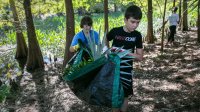8 Simple Steps to Launching an Outdoor Learning Program
Learning outside regularly—whether for a class period or on a multiday trip—can improve students’ academic performance and health.
Your content has been saved!
Go to My Saved Content.In addition to the many challenges of the past year and a half, nearly every educator can name a few unexpected opportunities brought on by the pandemic. Some integrated educational technology into their classrooms for the first time. Others learned the true value of differentiation when teaching from a distance.
And for some of us, the greatest opportunity that the pandemic provided was the opportunity to teach—and learn—outside. For example, at my school, we were fortunate enough to teach all of our classes outdoors for most of this past year. We used a local national forest for grade-level outdoor education trips. And now, with school resuming, we are finding that most of us still prefer outdoor venues for most meetings and gatherings.
Beyond the proven health and safety benefits of teaching outside during a pandemic, outdoor education is linked to a wide variety of positive results in areas such as overall school performance; physical, mental, and social health; reduced levels of stress, anxiety, and ADHD; and emotional and behavioral development, among others. It also provides a natural and easily accessible antidote to the skyrocketing screen time we’ve witnessed since the dawn of Covid-19.
Despite this evidence, many schools still hesitate to host outdoor education programs due to concerns about location, scheduling, budget, and safety.
For those interested in launching, modifying, or revisiting outdoor education as a pedagogical tool, consider harnessing the challenges of the past year and a half as an opportunity to act. Whether your goal is to develop multiweek expeditions in the backcountry or to simply build a community garden behind the school gym, these eight simple steps can help drive your planning.
Getting Students Outdoors
1. Start with “Why?”: What are your learning outcomes? Do you want to focus on outdoor expeditions or adventures, environmental science, or just create outdoor learning spaces? Much of this depends on your school’s location, budget, and current commitment to outdoor education, so tailor your objectives to your context. Determining these programmatic goals up front can both unify your school community and clarify program goals and expectations.
2. Make it relevant: Once you’ve answered “Why?” move on to answering “So what?” Do your research and align the program with the school, district, or state standards and/or strategic goals of the school. Consider all the relevant stakeholders involved—faculty and staff, administration, alumni, district/state officials, board of trustees, and parents. Learn to be fluent in the language of your key decision-makers. It will pay off in the long run.
3. Learn from others: More often than not, the program you desire to create is already in place at another school. Do your research and contact existing programs that are aligned with your programmatic goals. The outdoor community is incredibly collaborative and willing to assist fellow enthusiasts. Don’t waste precious time reinventing the wheel.
4. Consider locations, scheduling, and funding: Traditionally, the biggest barriers to experiential education in secondary school settings are adequate locations, schedules, and funding. Proactively identifying your needs while researching and proposing some solutions within these three realms up front is essential when both launching a new program and modifying an existing one.
For example, some schools start by simply identifying a sunny patch of unused land on campus to install raised garden beds. Others take advantage of local county or state parks for class trips, retreats, or other related activities.
5. Develop a proposal: With the above settled, it’s time to develop your pitch. Start by compiling relevant research and data and preparing a risk management analysis. Brainstorm and anticipate concerns regarding safety, adult supervision, loss of academic classroom time, scheduling constraints, and logistics.
For example, if you know that afternoon thunderstorms are common in the area where you’ll be, how will you mitigate those risks? How many vehicles will you need to abide by rapidly changing Covid-19 protocols? Prepare thoughtful, honest responses that align with the needs and wants of your decision-makers.
6. Engage community stakeholders: Though it is time-consuming and tedious, including faculty, staff, parents, and former students as early and often as possible is essential to establishing community buy-in from the start. Consider creating planning committees with the most enthusiastic members of these groups for consistency. Your proposal will be strengthened by support and ownership from the broader school community.
7. Develop assessment and evaluation methodologies: Although your programs will likely include a plethora of colorful, anecdotal evidence of success, it’s important to prepare for the skeptics during the spring budget-planning season. To counter expected criticisms or proposed cuts, plan to collect both quantitative and qualitative data, and consider your options regarding collection frequency and methodologies.
For example, many established programs focus on pre- and post-tests, surveys, anecdotal interviews, and deliberate reflection activities in the form of debriefs and/or after-action reviews. In addition, if you don’t have any data to start with, organizations such as the Association for Experiential Education (and their Journal of Experiential Education) contain a multitude of peer-reviewed articles with pertinent evidence supporting all forms of education outdoors.
8. Crawl, walk, run: When in doubt, start small. Under-promise and over-deliver. If this is a new program, focus on providing early evidence of success in order to justify follow-on sustainment or expansion.
We can all relate to the instinctual satisfaction of a breath of fresh air, a quiet walk along a creek, or a week in the mountains after a long, challenging year. As Walt Whitman wrote, “Now I know the secret of making the best persons; it is to grow in the open air and to eat and sleep with the earth.” Let’s harness the challenges of the past year as an unprecedented opportunity to guide our students back to the benefits of the natural world.
